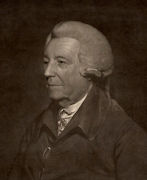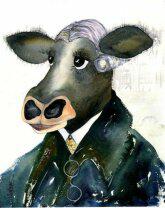Arthur Blayney
born 11 Feb 1716, died 1 Oct 1795
(see genealogy)Arthur was the youngest of 8 children and only male heir of John Blayney (b.1680) and Anne Weaver (d.1751/8) [79], who married in 1707. John was the only son of Henry Blayney of Gregynog (d.1691) and Mary (Elizabeth) Seddon [who had seven daughters]. Henry was the 3rd son and heir of Sir Arthur Blayney (1603-1659) and Joyce (Joyous) Blayney, heir of Gregynog and grandaughter of Lewis Blayney and Arthur's 1st cousin once removed, who had 4 sons and a daughter.
The last Blayney Gregynog heir and (as far as is possible to tell), the last male descendant of Sir Arthur Blayney [see Comment 1], second son of the first Lord Blayney, Baron of Monaghan was known as a Philanthropist. He was Sheriff in 1764 and considered a "fine country gentleman" who was kind and generous with his tenants. He gave land for the building of good roads, and encouraged the planting of trees [247]. He was noted as one of the few land owners who "built a number of comfortable cottages for the labouring classes". The Gregynog estate was at the forefront of agricultural improvement in the late 18th century under Arthur's "benign management" which included building "convenient and elegant houses" for the labourers with land for keeping a cow or two and at "very easy rents" [1360]
As a descenant of Brochwel Ysgythrog (a 7thC Prince of Powys), he "valued himself on his pedigree no otherwise than by taking care that his conduct should not disgrace it" [[339]. The door of Mr Blayney was equally open to the titled tourist as to the "wretch whose wanderings never knew the world's regard" [1020]. But not only was he humble, he clearly understood the principal of "hand up not hand out" as we read...."His charity was liberal and diffusive; but instead of confining it to the idle vagrant and clamorous poor, his chief aim was to put deserving objects in the way to afford them the means of providing for themselves" [[339].
He remodelled the Church of St Cynon at Tregynon before he died. His tomb is on the north side of the churchyard and the weathervane on the bell turret is as he huimbly requested, simply inscribed 'A B 1787' [146]. He also requested a very simple burial (without funeral) [see Comment 3]. "He was universally and justly lamented, an advantage which amiable men possess over great ones [[339].
The search for a male heir to the Lord Blayney title to the Barony of Monaghan in Ireland had moved to Sir Arthur's family, as the first son (Henry) had no surviving male heir after the death of Cadwallader Davis Blayney, the 12th Lord in 1874 [55]. [see Comment 2]
Arthur Blayney
Arthur Blayney
[Gwasg Gregynog]
Arthur Moo-BlayneyArthur left both Gregynog and Morville to the last Lord Tracy of Toddington, who had married his cousin on his mother's side Susan) WEAVER. The Gregynog and Morville estates then passed through their daughter Henrietta Susanna Tracy and her husband Charles Hanbury Tracy Esq, MP, 1st Lord Sudeley of Toddington.
The UK National Portrait Gallery in London (St Martin's Place) has on archive a portrait by George Henry Fitzroy, 4th Duke of Grafton (or more probably Thomas Hardy), after Sir William Beechey (Portrait painter), mezzotint, late 18th century (to the right). A larger version is available on-line at NPG D749
An interesting woodcut by Rigby Graham (2nd picture on right) of Arthur Blayney is shown in the Gregynog Press release "Readings from Thomas Pennant's The Tour in Wales (1776-1784)" Ed. Gwyn Walters. See Gwasg Gregynog.
A beer, "Blayney's Brew" was developed by brewer Pam Honeymen as a tribute to Arthur and is now served in the Courtyard café at Gregynog Hall. Authur further inspired Mid Wales artist Julia Harris to create one of her popular humorous "Moo" paintings in his honour, and this now hangs in the same Courtyard café -(3rd picture on right) See Moo-honour-for-squire.
Comment 1: Sir Arthur (Lt Col) Blayney (1603-1659) commanded Royalist Welsh regiments at First Newbury battle of 1643 in the First English Civil War: 1642-1646). He was the second son of Edward (who became the 1st Lord Blayney). He married Joyce the daughter of his cousin (1st cousin once removed). He must have returned to Wales from Ireland. Sheriff of Montgomery 1644.
Comment 2: "The Welsh Blayneys did not die out but became impoverished and had to leave the estate at Gregynog when it was sold to cover the debts of a relative of Sir Arthur Blayney, in who's business affairs he had unfortunately become involved." [102] This claim implies that "Arthur married more than once and it is possible that his six children were not all by the same woman but are likely to have become the responsibility of the latest wife if he died while they were dependant." Clearly there is confusion about which Arthur was the last, as the Arthur who married twice, (Mary (Margaret) Forbes, having 5 children then to Jane Smothergill, having 6 children was not the last Arthur Blayney (1716-1795), son of John Blayney and Anne Weaver, but John's uncle. See the Edward1.html#SirA genealogy. However, a Henry Blaine, the dependant of an impoverished widow named Joan, may well be have been one of Jane Smothergill's sons! [102]
Comment 3: Arthur's request.
Ar: Blaney's [sic] Last Directions [333] It is usual for people in this country (out of pretended respect but rather from an impertinent curiosity) to desire to see persons after they are dead. It is my earnest request that no person on any pretence whatever may be permitted to see my corpse but those who unavoidably must. I desire to be buried in the north side of the churchyard of Tregynon somewhere about the centre my coffin to be made in the most plain and simple manner without the usual fantastical decorations and the more perishable the material the better. I desire that no undertaker or professed performer of funerals may be employed: but that I may be conveyed to the churchyard in some country hearse which may be hired for the occasion and my corpse to be carried from hearse to the grave immediately without going into the church by six of the chief Tregynon tenants to whom I give two guineas each for their trouble. It is my earnest request and desire to have no upper bearers or any persons whatever invited to my funeral which I desire may be at so early an hour as will best prevent a concourse of people from collecting together: the better sort I presume will not intrude as there is no invitation. I have been present at the funerals of three of my uncles at Morville. I was pleased with the privacy and decency with which all things were conducted: no strangers attended all was done by the servants of the family. It is my earnest desire to follow these examples however unpopular and that no coach no escutcheon and no pomp of any kind may appear. I trust that my executor will be well justified against the clamor and obloquy of mercenary people when he acts in performance of the last request of a dying friend who solemnly adjures him in the name of God punctually to observe these directions. codicil I likewise give to all my servants five guineas each in lieu of all mourning which it is my desire no person may use on my account.


